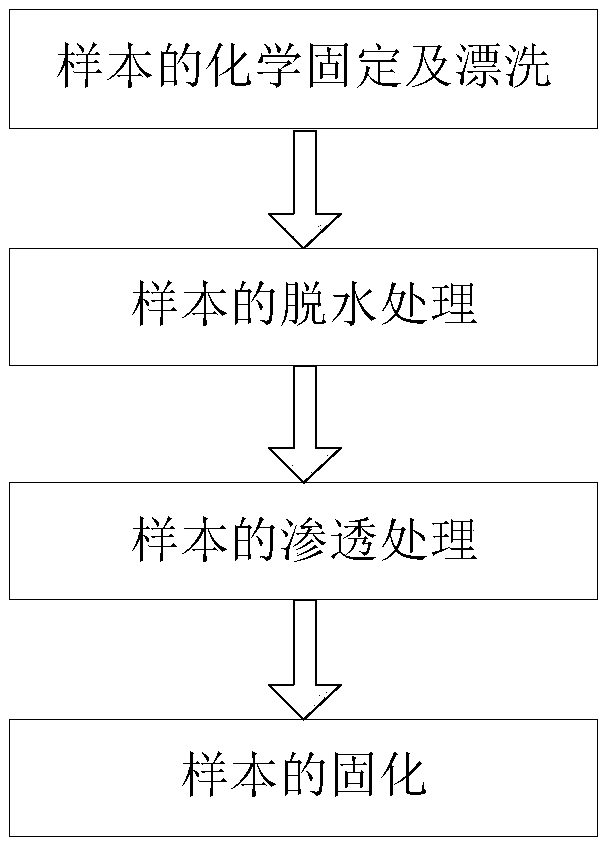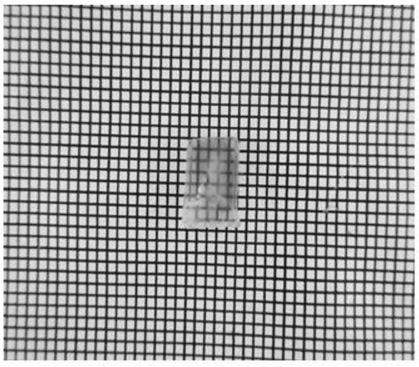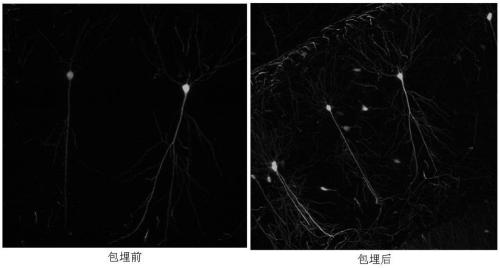Embedding agent, embedding method and application of light-transparent biological tissue
A biological tissue and embedding agent technology, applied in the field of biological imaging, can solve the problems of incompatibility, inconvenient storage of samples, and difficulty in maintaining fluorescence signals for a long time, and achieve the effects of rapid imaging, long fluorescence signal time, and easy availability of reagents.
- Summary
- Abstract
- Description
- Claims
- Application Information
AI Technical Summary
Problems solved by technology
Method used
Image
Examples
Embodiment 1 and 2 and 4
[0061] An embedding method of an embedding agent for biological tissue, which is a medium and low temperature solidification embedding method, figure 1 It is the process of resin embedding biological tissue transparent method, such as figure 1 shown, including the following steps:
[0062] (1) Biological tissue pretreatment: firstly, after perfusion, the mouse brain was taken out and fixed in 4% paraformaldehyde (PFA) for 24 hours; then rinsed with PBS solution for 3 times, 8 hours each time. Then use tetrahydrofuran / distilled aqueous solution to dehydrate according to the gradient at 4°C, 50% tetrahydrofuran / 2 hours+75% tetrahydrofuran / 2 hours+95% tetrahydrofuran / 2 hours+100% tetrahydrofuran / 2 hours+100% tetrahydrofuran / 4 hours;
[0063] (2) Permeation: then immerse the dehydrated rat brain in the prepared resin monomer at 4°C in a dark environment for 2 hours, then change the liquid, and then immerse for 2 days;
[0064] (3) Curing: The embedding agent is as shown in Table...
Embodiment 2
[0067] An embedding method of an embedding agent for biological tissue, comprising the steps of:
[0068] Step (1) and step (2) are the same as embodiment 1.
[0069] (3) curing: the embedding agent is as shown in table 1, by weight, the mixture of 95 parts of acrylate monomer phenyl methacrylate shown in table 1 and 5 parts of crosslinking agent tetraethylene glycol diacrylate After mixing with 1 part of initiator azobisisoheptanonitrile according to the weight ratio of 99:1, blow with nitrogen gas at a certain flow rate for 30 minutes, and store the mixed resin monomer in a refrigerator at -30°C for later use;
[0070] Finally, put the infiltrated mouse brain in the capsule and add the mixed spare resin monomer, then put it in a vacuum oven, and cure it according to the set curing conditions, and wait for it to slowly drop to room temperature and cool down, then the imaging process can be carried out , wherein the curing conditions and specific steps are: curing at an initi...
Embodiment 3
[0072] (1) Biological tissue pretreatment: First, take out the rat brain after perfusion and place it in 4% paraformaldehyde (PFA) and fix it for 24 hours; then slice the rat brain with a vibrator, and then rinse it with PBS solution for 3 times, 8 hours each time. The fixed and rinsed biological tissues were immunohistochemically labeled with Alexa 488, an organic fluorescent dye molecule. First, use 20% DMSO and 0.2% Triton X-100 PBS solution to perforate 100 micron mouse brain tissue slices for 12 hours, then add 10% serum to block for 12 hours, rinse with PBS for 1 hour / 3 times, and then follow Add the primary antibody at a ratio of 500:1 and incubate with shaking at 37°C for 2 days in the dark, then incubate with shaking at 37°C for 2 days in the dark and then add the secondary antibody at a ratio of 800:1 and incubate at 4°C for 8 hours in the dark and then use PBS Rinse for 1 hour / 3 times.
[0073] (2) Permeation: After fluorescent dye immunohistochemistry, the brain ...
PUM
| Property | Measurement | Unit |
|---|---|---|
| refractive index | aaaaa | aaaaa |
| refractive index | aaaaa | aaaaa |
| refractive index | aaaaa | aaaaa |
Abstract
Description
Claims
Application Information
 Login to View More
Login to View More - R&D
- Intellectual Property
- Life Sciences
- Materials
- Tech Scout
- Unparalleled Data Quality
- Higher Quality Content
- 60% Fewer Hallucinations
Browse by: Latest US Patents, China's latest patents, Technical Efficacy Thesaurus, Application Domain, Technology Topic, Popular Technical Reports.
© 2025 PatSnap. All rights reserved.Legal|Privacy policy|Modern Slavery Act Transparency Statement|Sitemap|About US| Contact US: help@patsnap.com



